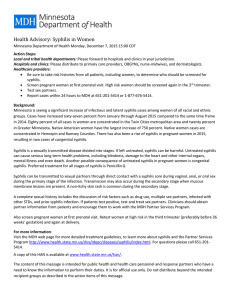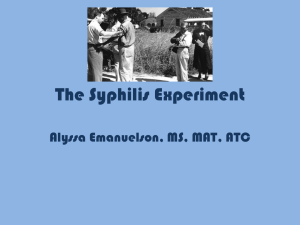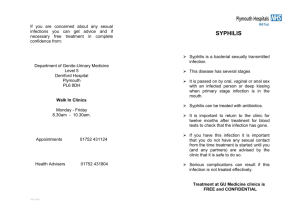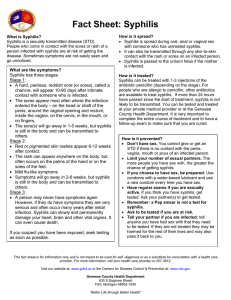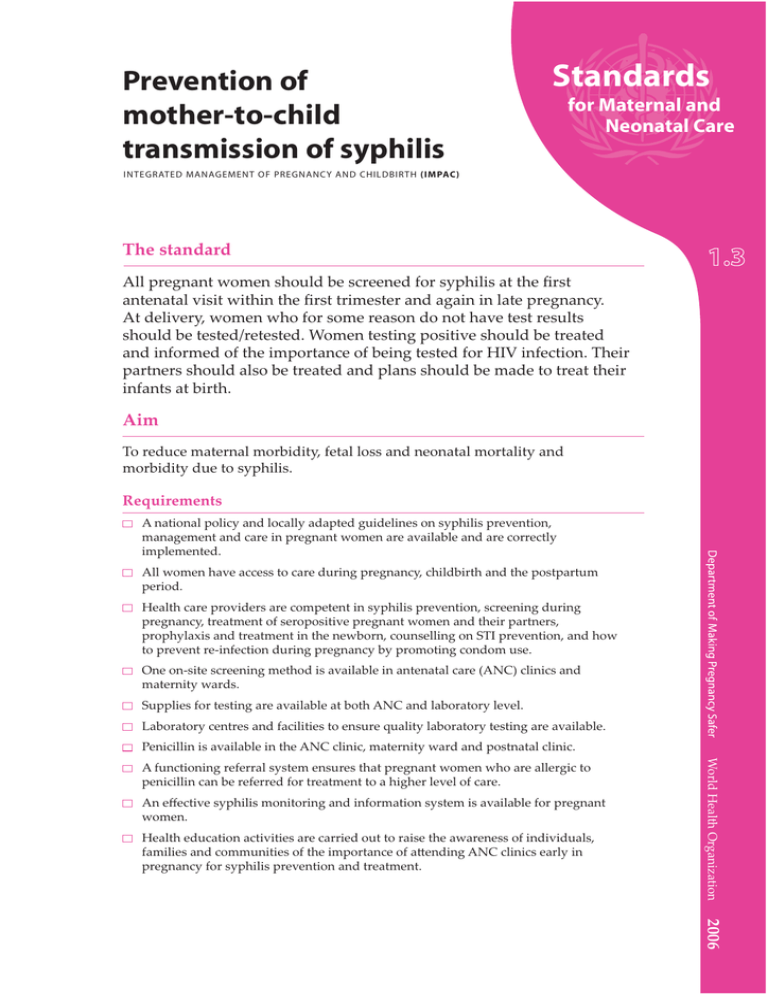
Prevention of
mother-to-child
transmission of syphilis
Standards
for Maternal and
Neonatal Care
INTEGRATED MANAGEMENT OF PREGNANCY AND CHILDBIRTH (IMPAC)
The standard
ȱȱ ȱȱȱȱȱ¢ȱȱȱęȱ
ȱȱ ȱȱęȱȱȱȱȱȱ¢ǯȱ
At delivery, women who for some reason do not have test results
should be tested/retested. Women testing positive should be treated
and informed of the importance of being tested for HIV infection. Their
partners should also be treated and plans should be made to treat their
infants at birth.
Aim
To reduce maternal morbidity, fetal loss and neonatal mortality and
morbidity due to syphilis.
Requirements
A national policy and locally adapted guidelines on syphilis prevention,
management and care in pregnant women are available and are correctly
implemented.
All women have access to care during pregnancy, childbirth and the postpartum
period.
Health care providers are competent in syphilis prevention, screening during
pregnancy, treatment of seropositive pregnant women and their partners,
prophylaxis and treatment in the newborn, counselling on STI prevention, and how
to prevent re-infection during pregnancy by promoting condom use.
One on-site screening method is available in antenatal care (ANC) clinics and
maternity wards.
Supplies for testing are available at both ANC and laboratory level.
Laboratory centres and facilities to ensure quality laboratory testing are available.
Penicillin is available in the ANC clinic, maternity ward and postnatal clinic.
ȱ ȱěȱ¢ȱȱȱȱ¢ȱȱȱȱȱ
women.
Health education activities are carried out to raise the awareness of individuals,
ȱȱȱȱȱȱȱĴȱȱȱ¢ȱȱ
pregnancy for syphilis prevention and treatment.
World Health Organization
A functioning referral system ensures that pregnant women who are allergic to
penicillin can be referred for treatment to a higher level of care.
2006
Standards
1.3
Prevention of mother-to-child transmission of syphilis
2
Applying the standard
ȱȱȱȱȱȱǰȱȱȱȱĴǰȱDZ
ȱ ȱȱȱ ȱȱ¢ȱ ȱȬȱȱȱȱȱȱȱȱȱęȱ
antenatal visit. Screening should be done preferably before 16 weeks of gestation to prevent
congenital infection, and again in the third trimester.
Review syphilis test results at subsequent visits and at time of delivery. If the woman was not
ȱȱ¢ǰȱ¢ȱȱȱȱěȱĞȱ¢ǯ
Treat all seroreactive women with benzathine benzylpenicillin at the recommended dosage
ȱȱȱŘǯŚȱȱȱ¢ȱȱȱȱǰȱĞȱȱ¡ȱ¢ȱȱ
ǯȱȱȱȱȱ¢ȱȱǰȱȱĴȱȱ£ȱȱȱ ȱ
penicillin if trained to do so, or refer the patient to a higher level of care.
Advise women who test positive that their partner(s) must also be treated with the same
ǰȱȱ ȱȱȱ¢ȱȱȱȱȱĞȱǯȱ
Advise women who test negative how to remain negative by promoting condom use during
pregnancy.
Test for syphilis all women with a history of adverse pregnancy outcome (abortion, stillbirth,
syphilitic infant, etc.) and treat accordingly.
Treat women with clinical disease or a history of exposure to a person with infectious syphilis.
Screen all women with syphilis for other STIs and HIV infection, and provide counselling and
treatment accordingly.
ȱ ěȱ¢ȱȱȱȱȱ
ȱȱȱ ȱ ȱȱȱȱ¢ǯ
Make plans for treating the baby at birth.
Record testing results and treatment in the facility’s logbook and in the woman’s card.
Audit
Input indicators
A national policy and locally adapted guidelines on syphilis prevention, management and care
in pregnant women are available and are correctly implemented.
The proportion of health facilities providing ANC that have a screening test for syphilis
available.
The availability of a screening test for syphilis in primary level health facilities.
The availability of penicillin at the primary care level (including ANC and childbirth care).
Health providers know when and how to perform the RPR test or VDRL (Venereal Disease
Research Laboratory) test or the test which is available in the facility.
Health providers know when and how to treat or refer women and their infants with syphilis.
Process and output indicators
Coverage of RPR testing (or other used test) in pregnant women in ANC.
Coverage of correct treatment in the ANC clinic.
Coverage of partners tested and treated accordingly.
Coverage of asymptomatic babies born to a positive mother who received prophylactic
treatment.
Outcome indicators
Incidence of congenital syphilis.
Perinatal and neonatal mortality and morbidity due to congenital syphilis.
Stillbirth rate.
Standards
1.3
Prevention of mother-to-child transmission of syphilis
3
Rationale
ȱȱě
¢ȱȱȱǰȱĞȱȱȱ
with some clinically recognizable stages.
Where the disease is prevalent most cases may
be asymptomatic. Although estimates vary,
at least 50% of women with acute syphilis
ěȱȱ¢ȱǯȱȱ
adverse pregnancy outcomes are estimated
ȱȱȱȱ DZȱśŖƖȱȱȱ
or spontaneous abortion, and 50% perinatal
death, serious neonatal infection or low birth
weight. Mortality in infected infants can be
higher than 10% (1).
The more recent the maternal infection, the
ȱ¢ȱȱȱ ȱȱěȱ(2).
Transmission occurs more commonly in the
last two trimesters, but the spirochete can cross
the placenta at any time during pregnancy
(2). Clinical similarity with other congenital
diseases and the limitations of diagnostic tests
ȱȱĜȱȱȱȱȱ¢ȱȱ
in the newborn (1).
Ĝ¢ȱȱě
Syphilis control in pregnant women through
universal antenatal screening and treatment
of positive cases has been established as a
ȱȱȬěȱȱ(3,4),
especially owing to the high direct and indirect
cost of complications of syphilis in pregnancy
(5)ȱȱȱ¢ȱȱȱȱěȱ
therapy (6–8). Nevertheless, in low-income
countries a number of technical, logistical and
structural constraints make case detection and
ȱȱȱȱĜȱ
(4,9), resulting in avoidable perinatal mortality
(10,11).
Non-treponemal tests such as RPR and VDRL
are helpful indicators of infection and are
cheaper and easier to perform than treponemal
tests. Their sensitivity increases from primary
ȱ¢ȱ¢ǰȱ ȱȱę¢ȱȱ
generally high in the absence of an underlying
chronic condition (7); they are therefore useful
ȱ ȬȱĞȱȱ(6–8,12). Titres
ȱěȱȱ¢ȱȱ ȱȱ
ȱȱĞȱȱǻŝǼǯȱȱȬȱ
RPR test is quick and simple to use, and allows
treatment to be given immediately if indicated;
ȱȃȱȄȱȱȱȬěȱ
ȱĴȱ ȱ¢ȱȱȱȱ
than 0.15% (13). Nevertheless, these tests
¢ȱȱȬȱȱȱȱěȱ
mother or her baby (7,14). RPR and VDRL
can also give false-positive results owing to
tissue damage from other causes, such as
viral infections, vaccinations, intravenal drug
abuse and chronic disease (7). Ideally, nonȱȱȱȱęȱ¢ȱȱ
treponemal test. Treponemal tests such as
the Treponema pallidum haemagglutination
assay (TPHA) have higher sensitivity and
ę¢ȱȱȱȱȱ ȱȱ
¢ǰȱȱĜȱȱ¢ȱȱǰȱ
and are thus not recommended for primary
health care facilities (7,15,16). Therefore, the
lack of resources and higher prevalence of
syphilis in less developed countries justify the
treatment of all people testing seropositive
with RPR (12).
New treponemal-based tests for syphilis make
Ȭȱȱǯȱȱȱěȱ
screening tests for syphilis are now available,
which can even be used at the lowest levels
of health service delivery. A simple strip of
paper, impregnated with treponemal antigen,
ȱȱȱȱȱȱ¢ȱęȱǯȱ
Results are available in just a few minutes.
These point-of-care diagnostic tests are
ǰȱěȱȱȱȱǯȱ
Unlike earlier diagnostic tests, they do not
require access to a laboratory or a refrigerator.
ȱǰȱȱ ȱȱěȱȱȱ
alternative to older techniques. These tests
have the potential to change the whole
approach to syphilis testing even in isolated
clinics. Because the results can be available
immediately, women can be tested and receive
treatment at the same visit. The new tests cost
a mere US$ 0.93-1.44 per woman screened
(16). Although this is more costly than the
previous standard tests, the new tests are in
ȱȱȬěǰȱȱȱ ȱ
can be tested and treated in a timely manner
and hence more cases of congenital syphilis
prevented. It is estimated that the new rapid
ȱȱȱȱ¢ȱǞȱŝȱȱ
each case of congenital syphilis averted (17).
Adequate penicillin treatment usually ends
infectivity within 24–48 hours. A Cochrane
review (18) indicates that, while there is no
ȱȱȱȱěȱȱȱ
syphilis in pregnancy and in preventing
congenital syphilis, uncertainty remains about
the optimal treatment regimen (dose, duration
and preparation) (18). Benzylpenicillin,
administered parenterally in a single dose,
is the preferred drug for treating pregnant
women and prevent mother-to-child
transmission of syphilis (6–8,18).
Standards
1.3
Prevention of mother-to-child transmission of syphilis
Single dose, however, won’t treat latent
syphilis in pregnant women. Based on
the available evidence, pregnant women
with a history of penicillin allergy should
be desensitized before treatment with
benzylpenicillin (8).
International guidelines recommend that
every woman who tests seropositive for
syphilis be also tested for HIV infection (8).
Although there is no conclusive evidence,
4
it is possible that HIV coinfection alters the
predictive value of diagnostic tests (7,8,15).
HIV coinfection could increase the possibility
of early development of neurosyphilis and
could increase the possibility of treatment
failure; some guidelines therefore suggest
modifying currently recommended dose
regimens in the case of HIV coinfection
(6–8) (see also standard 1.2 “Prevention and
ȱȱ¡¢ȱĴȱȱ
reproductive tract infections”).
The table below summarizes the evidence from the most relevant studies. The level of evidence is
presented using the NICE methodology which applies a coding from 1 (high level) to 4 (low level).
For details, see also the ȱȱȱȱȱȱȱȱȱand theȱȱ
ȱȱȱȱȱȱȱȱȱȱĴDZȦȦ ǯ ǯȦȏ¢ȏ
safer/publications/en. For an overview of a comprehensive list of evidence, please refer to the
reference section of the standard.
Study
ǻ¢ȱǭȱȱ
ȱǼ
Population &
Ĵ
10. Rotchford
et al. 2000
158 pregnant
women with
syphilis
ȱ
study
2+
ANC clinical
ĴDzȱȱ
Africa
Baseline risk
– Syphilis
prevalence
among pregnant
women 9%
(8–10%)
– Perinatal death
ȱěȱȱ
inadequately
treated pregnant
women with
syphilis 20%
18. Walker 2004
26 studies met
the criteria for
detailed scrutiny;
none of the studies
included in the
review
Most recent
substantive
amendment
March 2001
Systematic
ȱ
1++
a
Number needed to treat
ȱǭȱ
Outcomes linked
to the Standard
Results
To study the impact on
perinatal mortality of
inadequate treatment for
maternal syphilis
despite adequate screening
Inadequate syphilis
treatment
ȱę
Partner treatment
30%
ę
– Complete syphilis
DZȱȱȱ
of penicillin at weekly
intervals (2.4 mega-units of
benzathine benzylpenicillin
intramuscularly)
– Adequate syphilis
DZȱ ȱȱȱ
doses of penicillin
– Inadequate syphilis
DZȱȱȱȱȱ
of penicillin
Perinatal death
Adequate vs
inadequate
treatment
To identify the most
ěȱȱȱ
for syphilis in pregnant
women, with and without
concomitant HIV infection
ŝŝƖ
26%
a
NNT 5 (3–13)
While there
is no doubt
that penicillin
ȱěȱȱ
the treatment
of syphilis in
pregnancy and
in the prevention
of congenital
syphilis,
uncertainty
remains about
optimum
treatment
regimens
Comments
ȱěȱ
screening,
many pregnant
women with
syphilis remain
inadequately
treated,
resulting in
avoidable
perinatal
mortality
Standards
Study
ǻ¢ȱǭȱȱ
ȱǼ
8. CDC 2002
Guideline
4
1.3
Prevention of mother-to-child transmission of syphilis
Title & author/
organization
¡¢ȱĴȱ
diseases treatment
guidelines
Centres for Disease
Control and
Prevention
United States
Contents of the recommendations
All patient who have syphilis should be tested for HIV
infection.
Coinfection with HIV can increase the risk of neurologic
complication and the risk of treatment failure with currently
recommended regimens.
All women should be screened serologically for syphilis at
ȱęȱȱǯȱȱĴȱȱȱ¢ȱǰȱ
serologic testing should be performed twice during the third
trimester.
ȱȱȱȱȱ¢ȱ¢ȱ ȱȱ
Ĝ¢ȱȱ¢ȱȱ¢ǯ
5
Comments
Parenteral
benzylpenicillin has
ȱȱě¢ȱ
for syphilis treatment
and prevention for
more than 50 years;
nevertheless, no
comparative trials
have been adequately
conducted to guide
the selection of an
optimal regimen
(dose, duration and
preparation)
Based on available evidence, pregnant women who have a
history of penicillin allergy should be desensitized and treated
with penicillin
References
ŗǯȱ ȱ
ȱȱǯȱȱȱȱȱȱȱ¢DZȱȱ ȱȱ
recommendations. ȱȱȱȱ
ȱ£ǰȱŘŖŖŚǰȱŞŘDZŚŘŚȮŚřŖǯ
Řǯȱ ȱǯȱȱ¢DZȱ¢¢ȱȱǯȱȱȱȱȱ
ȱ
£ǰȱŘŖŖŚǰȱŞŘDZŚřřȮŚřŞǯȱ
3.
Connor N, Roberts J, Nicoll A. Strategic options for antenatal screening for syphilis in the
ȱDZȱȱȱěȱ¢ǯȱȱȱȱǰȱŘŖŖŖǰȱŝDZŝȮŗřǯ
4.
Schmid G. Economic and programmatic aspect of congenital syphilis prevention. ȱȱ
ȱȱ
ȱ£ǰȱŘŖŖŚǰȱŞŘDZŚŖŘȮŚŖşǯ
5.
Bateman DA et al. The hospital cost of congenital syphilis. ȱȱǰȱŗşşŝǰȱŗřŖDZŝśŘȮ
ŝśŞǯ
Ŝǯȱ ȱǰȱ
ȱǰȱȱǯȱěȱȱȱę¢ȱȱǻ
Ǽȱȱ
on the course of syphilis and on the response to treatment. ȱȱȱ, 1990,
ŗŗřDZŞŝŘȮŞŞŗǯ
ŝǯȱ ȱȱȱȱǯȱȱȱȱ
ȱȱȱȱ¡¢ȱ
ĴȱǯȱDZȱȱȱȱȱ, 2nd ed. Rockville, MD, Agency for
ȱȱȱ¢ǰȱŗşşŜǰȱŝŘřȮŝřŝǯ
Şǯȱ ȱȱȱȱȱǯȱ¡¢ȱĴȱȱȱlines – 2002. ¢ȱȱ¢ȱ¢ȱǰȱŘŖŖŘǰȱśŗDZŗȮŞŖǯ
şǯȱ ȱȱȱǯȱȱȱȱ¢ȱDZȱȱȱȱǰȱ
Kenya and South Africa. ȱȱȱȱ
ȱ£ǰȱŘŖŖŚǰȱŞŘDZŚŗŖȮŚŗŜǯ
10. Rotchford K et al. Impact on perinatal mortality of missed opportunities to treat maternal
¢ȱȱȱȱDZȱȱȱȱȱȱ£ȱȱǯȱ
ȱȱǭȱȱ
ǰȱŘŖŖŖǰȱśDZŞŖŖȮŞŖŚǯ
11. Goldenberg RL, Thompson C. The infectious origins of stillbirth. ȱȱȱȱ
ȱ¢¢ǰȱŘŖŖřǰȱŗŞşDZŞŜŗȮŞŝřǯ
ŗŘǯȱ ȱǯȱȱȱȱȱȱȱȱȱȱ¢DZȱ
an overview. ȱȱȱȱ
ȱ£ǰȱŘŖŖŚǰȱŞŘDZŚřşȮŚŚŜǯ
ŗřǯȱ ȱȱȱǯȱěȱȱȮęȱȱȱȱȱ¢ȱȱ
and treatment program at a county jail. ¡¢ȱĴȱǰȱŘŖŖŖǰȱŘŝDZśŖŞȮśŗŝǯ
ŗŚǯȱ £ȱȱȱǯȱȱȱȬȱȱȱ¢ȱȱ¢DZȱȱȱȱ
Mozambique. ȱȱȱǰȱŗşşŘǰȱŗŘDZŚŚśȮŚśŖǯ
ŗśǯȱ ȱȱȱǯȱȱęȱȱȱȱȱȱ¢ǯȱ¢ȱȱ
HIV Study Group. ¡¢ȱĴȱǰȱŗşşŞǰȱŘśDZśŚşȮśśŘǯ
Standards
1.3
Prevention of mother-to-child transmission of syphilis
6
ŗŜǯȱ Ȭȱȱȱǯȱȱȱ¢ȱȱȱȬěȱȱȬȱ
Africa? ¡¢ȱĴȱǰȱŘŖŖřǰȱŝşDZřŝśȬřŞŗǯ
ŗŝǯȱ £ȱȱȱǯȱȱȬȱȱȱ¢ȱȱ ȱȱȱ
strip improves case detection and treatment in rural South African clinics, ȱȱȱ
ȱ
ȱ£ȱǻĴǰȱŘŖŖśǼǯȱȱ
ŗŞǯȱ ȱǯȱȱȱ¢ȱȱȱ¢ȱǻȱ ǼǯȱDZȱȱ
ȱ¢ǰȱȱŚǰȱŘŖŖŚǯȱǰȱȱ¢ȱǭȱǰȱŘŖŖŚǯ
Links and additional sources
I.
¡¢ȱĴȱȱȱȱȱǯȱȱȱȱȱ.
ǰȱȱ
ȱ£ǰȱŘŖŖśȱǻĴDZȦȦ ǯ ǯȦȬȦ
ȦȏȦ¡ǯǰȱȱŘȱ¢ȱŘŖŖŜǼǯ
II. ȱȱȱŘŖŖŘǯȱȱřǯȱȱ¡¢ȱĴȱȱȱȱ
ǯȱǰȱȱ
ȱ£ǰȱŘŖŖŘȱǻĴDZȦȦ ǯ ǯȦȬ
ȦȦȏȏȦŘŖŖŘȦ¡ǯǰȱȱŞȱǰȱŘŖŖŜǼǯ
III. Ȯ¢ȱDZȱȱȱȱȱ. Geneva, World Health
£ǰȱŗşşŜȱǻȱ
Ȧ
ȦȦȱşŚǯŗŗǼȱǻĴDZȦȦ ǯ ǯȦ
ȬȦȦȏşŚȏŗŗȦȏşŚȏŗŗȏȏȏǯǯǰȱ
accessed 13 December 2004).
IV. ȱȱȱȱ¢ȱȱȱȱDZȱȱȱ. Geneva, World Health
£ǰȱŗşşŝȱǻȱ
Ȧ
ȦȦşŚǯŘǼȱǻĴDZȦȦ ǯ ǯȦ
ȬȦȦȏşŚȏŘȦȏşŚȏŘȏŗǯǰȱȱŗřȱȱ
2004).
V.
Cloherty JP, Stark A, Eichenwald E. ȱȱȱǯȱĴȱȱǭȱ
Wilkins, 1998.
VI. ¢ǰȱǰȱȱȱ ȱDZȱȱȱȱȱ. Geneva,
ȱ
ȱ£ǰȱŘŖŖřȱǻĴDZȦȦ ǯ ǯȦȦŘŖŖřȦ
şŘŚŗśşŖŞŚǯǰȱȱŝȱȱŘŖŖŚǼǯ
This document
is not a formal
publication of
the World Health
Organization
(WHO), and
all rights are
reserved by the
Organization.
The document
may, however, be
freely reviewed,
abstracted,
reproduced and
translated, in part
or in whole, but
not for sale nor for
use in conjunction
with commercial
purposes.
This document is part of the
Standards for Maternal and Neonatal
ȱȱ¢ȱȱȱ
of Making Pregnancy Safer,
ȱ
ȱ£ǯȱȱ
For further information please
contactDZ
Department of Making Pregnancy
Safer (MPS)
World Health Organization (WHO)
20 Avenue Appia
ŗŘŗŗȱȱŘŝ
Switzerland
DZȱƸŚŗȱŘŘȱŝşŗȱřřŝŗ
¡DZȱƸŚŗȱŘŘȱŝşŗȱśŞśř
DZȱȓ ǯ
ȱDZȱ ǯ ǯȦȏ
¢ȏȦȦȦ
ȱȱȱȱȱȱȱĴȱȱ
DZȱȱȱǰȱǰȱȱȱȱ
ȱȱDzȱȱȱȱȱȱȱȱȱȱȱȱ
ȱĴǰȱ
ȱǰȱȱĴǰȱȱǰȱȱȱȱȱȱȱ
(Department of Making Pregnancy Safer).
ȱȱȱȱȱȱȱȱȱȱȱȱȱȱȱȱȱȱȱȱȱȱȱȱȱȱȱȱȱȱȱȱȱȱȱȱȱȱȱȱȱȱȱȱȱȱȱȱȱȱȱȱȱȱȱȱȱȱȱȱȱȱȱȱȱȱȱȱȱȱȱȱȱȱȱȱȱȱȱȱȱȱȱȱȱȱȱȱȱȱȱȱȱȱȱȱ
ȱȱ ȱȱ¢ȱȱĴȱ ȱȱȱȱȱȱȱ
ȱȱĴȱȱ
ȱȱĜȱȱ ȱȱȱȱȱ
ȱǰȱŗŚȬŗŜȱȱŘŖŖŘǯȱȱȱȱȱȱȱȱěȱȱȱ
ȬȱǻȱȱǰȱĴȱǰȱȱǰȱȱĴǰȱȱ
Baronciani and Nicola Magrini) developed the table of evidence and provided additional
ȱ ȱȱȱȱǯȱȱȱȱȱȱĴ ȱĴȱȱ
ȱȱȱȱȱĞǰȱȱȱȱȱȱȱȱ¢ȱȱ
the layout.
WHO acknowledges the generous contribution of over 80 individuals and organizations in the
ęȱȱȱȱȱȱ ȱȱȱȱ ȱȱȱȱěȱȱ
of its development.
The funding towards the preparation and production of this document provided by the
Governments of Australia, Italy and USA is gratefully acknowledged. In addition, WHO’s
Making Pregnancy Safer Department is grateful to the Governments of Denmark, Ireland,
Netherlands, Norway, Sweden, and the United Kingdom, and to the World Bank, UNICEF
ȱȱȱęȱȱǯȱ


